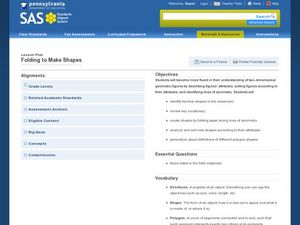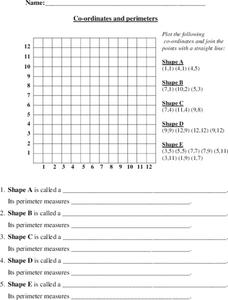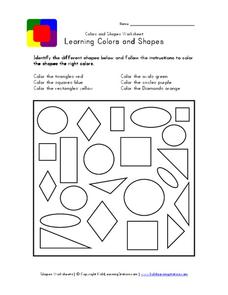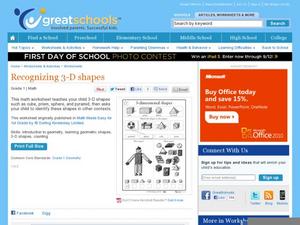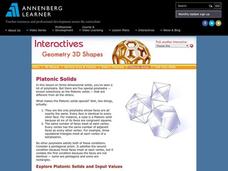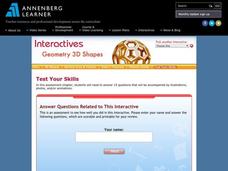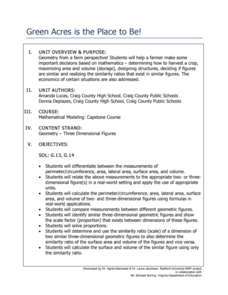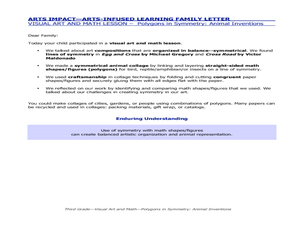Curated OER
Folding to Make Shapes
Second graders identify different polygons and their attributes. In this geometry lesson, 2nd graders get to know polygons by studying the vocabulary and finding polygons in their classroom. They create these shapes and then find their...
Curated OER
A Shapely Activity
Fifth graders explore polygons in various shape activities. For this polygons lesson, 5th graders discuss and identify polygons by their number of sides. Students sort ceramic tiles by the number of sides on each piece. Students explore...
Curated OER
2-D Shape Patten Placemats
Students identify and form a pattern out of 2-D shapes, then transfer this pattern into creating placemats.
Curated OER
Coordinates and Perimeters
Here is a lesson containing a great activity based on coordinates, and the perimeters of shapes created using a given set of coordinates. After youngsters creat a shape on a grid based on some coordinate pairs, they must identify which...
Curated OER
3rd Grade Math
In this math review activity, 3rd graders complete multiple choice questions about shapes, money, weight, and more. Students complete 20 questions.
Curated OER
Shape Hunt
Students explore two-dimensional and solid shapes. In this shapes and patterns geometry lesson, students work with a partner to create identifiable objects using tangrams. Students describe the attributes of their shape and their partner...
Curated OER
Learning Colors and Shapes
In this colors and shapes instructional activity, students look over a box full of different shapes, color the triangles red, squares blue, rectangles yellow, ovals green, circles purple and the diamonds orange.
Curated OER
3-Dimensional Shapes
Where is the vertex? Each of these three-dimensional figures is drawn so learners can see all sides and corners. They examine an example before trying six on their own. Some of these will be tricky, so be sure kids have covered this...
Annenberg Foundation
Geometry 3D Shapes: Platonic Solids
From polyhedrons to platonic solids, here is a lesson that will have your classes talking! As an introduction to platonic solids, scholars cut and fold nets to create the three-dimensional solids. They use an interactive component to...
Annenberg Foundation
Geometry 3D Shapes: Euler's Theorem
How do you get a theorem named after you? Euler knows what it takes! The third lesson of five asks pupils to use an interactive activity to compare the faces, vertices, and edges of seven different three-dimensional solids. They use...
Annenberg Foundation
Geometry 3D Shapes: Surface Area and Volume
Whether you wrap it or fill it, you're using geometric concepts. Classmates use an interactive approach to learn how to find volume and surface area of cylinders and prisms in the second lesson in a five-part series. The online lesson...
Annenberg Foundation
Geometry 3D Shapes: Test Your Skills
Time to find out what they've learned! The final lesson of a five-part series has learners complete a 39-question multiple choice review. They use what they've learned in the previous lessons to complete questions that include concepts...
Noyce Foundation
Part and Whole
Now you'll never have trouble cutting a cake evenly again. Here is a set of five problems all about partitioning shapes into a given number of pieces and identifying the fractional amount of each piece. As learners progress through the...
Radford University
Green Acres is the Place to Be!
Nurture a love of math and farming at the same time. Pupils apply geometry concepts, such as surface area and volume of three-dimensional shapes and similarity ratios, to farming contexts. They consider the dimensions of bales of hay,...
Curated OER
Parallel and Perpendicular Lines
Learners study parallel and perpendicular lines. In this parallel and perpendicular lesson plan, pupils explore 2-D shapes and determine if the sides are parallel or perpendicular.
Curated OER
Tiling Tessellations
Learners explore tessellations. In this shapes and geometry lesson, students describe the attributes of many of the shapes displayed on an Elmo. Learners create examples of tessellations using pattern blocks.
Curated OER
It's Not All Greek to Me
Learners find out the meaning for prefixes used in math vocabulary. By dissecting words used in everyday math, they figure out what the prefix indicates and what the word means. A variety of well-organized worksheets and activities...
Scholastic
Study Jams! Perimeter
Follow this engaging slide show on the calculation of polygon perimeter with some hands-on measurement of perimeters to solidify the concepts. On this webpage there are interactive assessment questions and links to related resources by...
Curated OER
Identify Shapes and Matching Parts
Students identify real world objects as shapes they have learned. In this 3-D shapes worksheet, students identify shapes such as a cube for a box, a sphere for a globe, and a cylinder for a soup can.
Curated OER
Terrific Tangrams
Third graders construct tangrams. In this tangrams lesson, 3rd graders manipulate basic shapes to construct tangrams. Students explore how shapes can be combined in different ways and develop spatial sense.
Curated OER
Shapes and Introduction to Geometry
Students make a quilt. In this geometry instructional activity, students discuss patchwork quilts and learn some different geometric shapes and patterns that are commonly used. Students explore designs with triangles and squares and then...
Curated OER
Third Grade Geometry
Third graders describe 2D and 3D shapes. In this geometry lesson plan, 3rd graders watch a PowerPoint presentation showing the terms used when analyzing shapes: vertex, edge, angle, side, and face. They compare shapes to see what they...
Curated OER
Obtuse Angles
Third graders recognize and identify geometric shapes, work with manipulatives to reinforce understanding, and create polygons with various angles to display their knowledge of the different types of angles.
Curated OER
Polygons in Symmetry: Animal Inventions
Fourth graders use polygons to create animal figures with symmetry. In this polygons and symmetry lesson, 4th graders create a symmetrical animal collage by cutting and gluing geometric shapes and figures from math activities.
